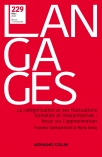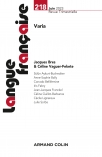
LITTÉRATURE Nº 217 (1/2025)
Pour acheter ce numéro, contactez-nous
Recevez les numéros de l'année en cours et accédez à l'intégralité des articles en ligne.
Cet article a pour objet une double confrontation de Séraphita, le roman « mystique » de Balzac, avec la pensée critique de Kant. D’un point de vue métaphysique, d’abord, il s’agit de mettre en relation Balzac, Kant et Swedenborg, celui-ci étant à la fois au centre de la fiction du romancier français et de l’opuscule que le philosophe allemand a consacrée au grand visionnaire ; d’un point de vue esthétique, ensuite, car Séraphita répond chez Balzac au projet de transposer sur le plan romanesque, en la sublimant, sa propre tendance mystique, tandis que, selon Kant, la théorie du symbolisme artistique permet à la fois à notre imagination de nous donner un plaisir esthétique spécifique et à notre entendement de réfléchir aux limites indépassables de la connaissance humaine.
The aim of this article is to compare Balzac’s “mystical” novel Séraphita with the critical thought of Kant. Firstly, from a metaphysical point of view, it compares Balzac, Kant and Swedenborg, the latter being at the heart of both the French novelist’s fiction and the German philosopher’s opuscule on the great visionary. Secondly, from an aesthetic point of view, Seraphita is Balzac’s attempt to sublimate and transpose his own mystical tendencies into a novel, while, according to Kant, the theory of artistic symbolism enables our imagination to give us specific aesthetic pleasure, and our understanding to reflect on the unsurpassable limits of human knowledge.

